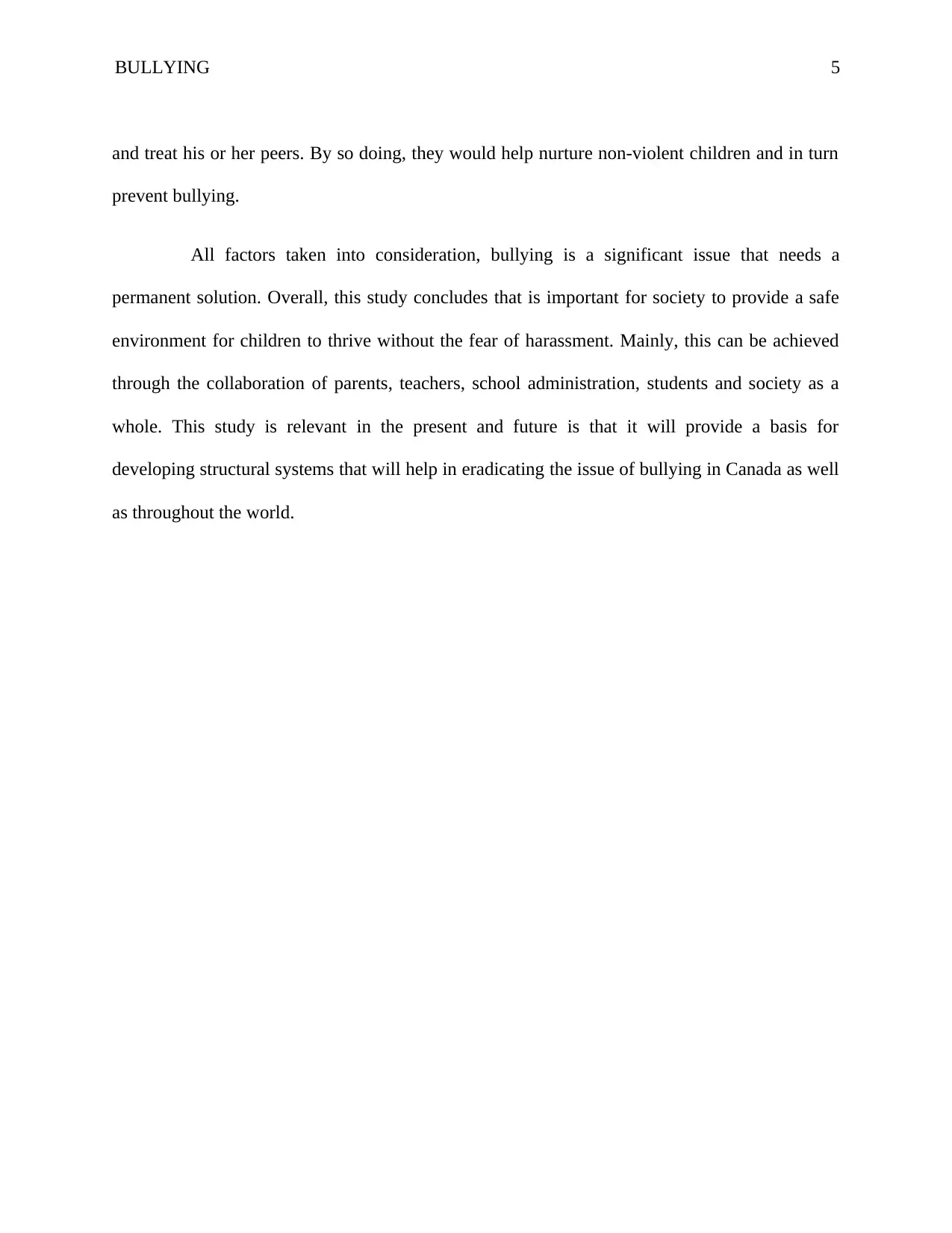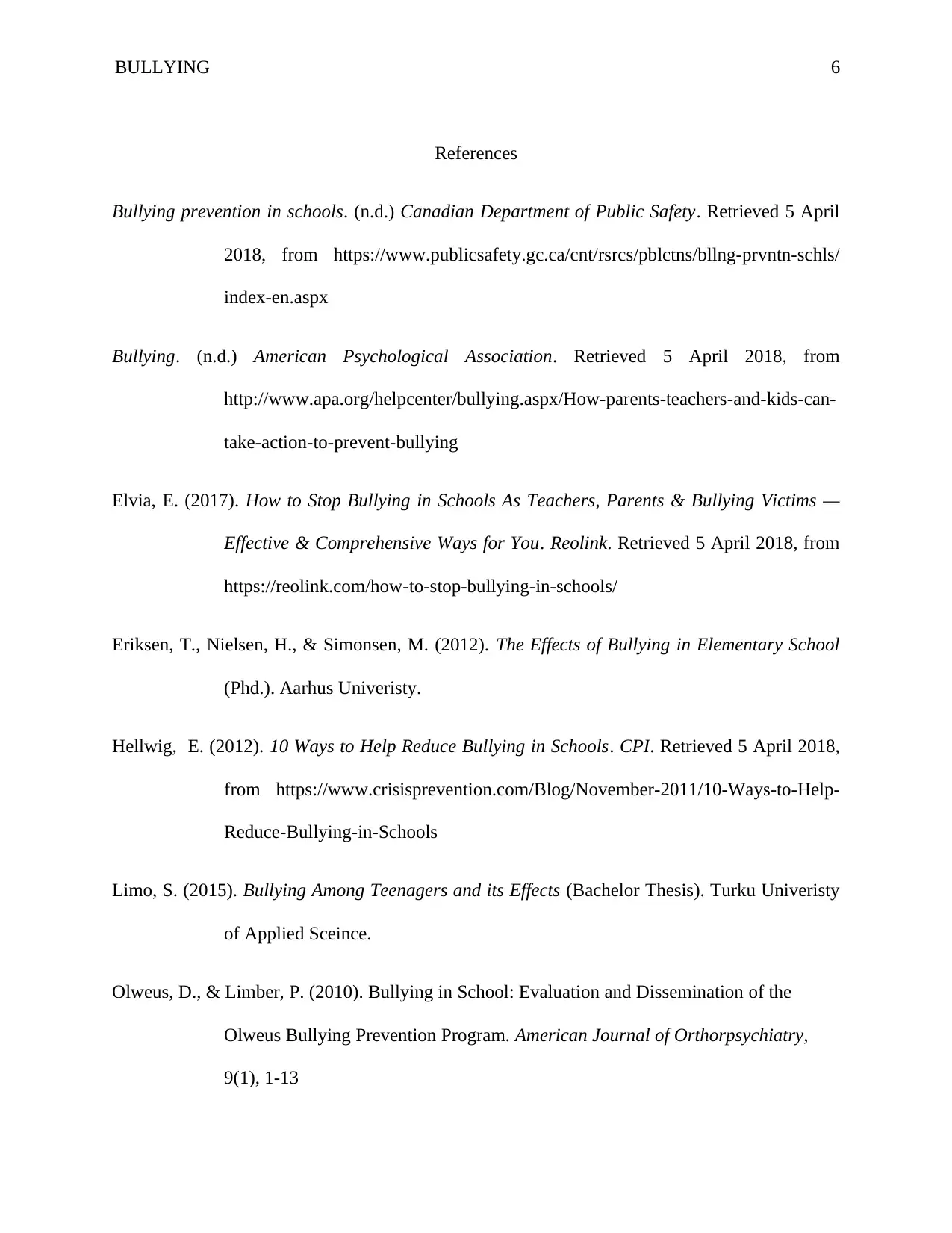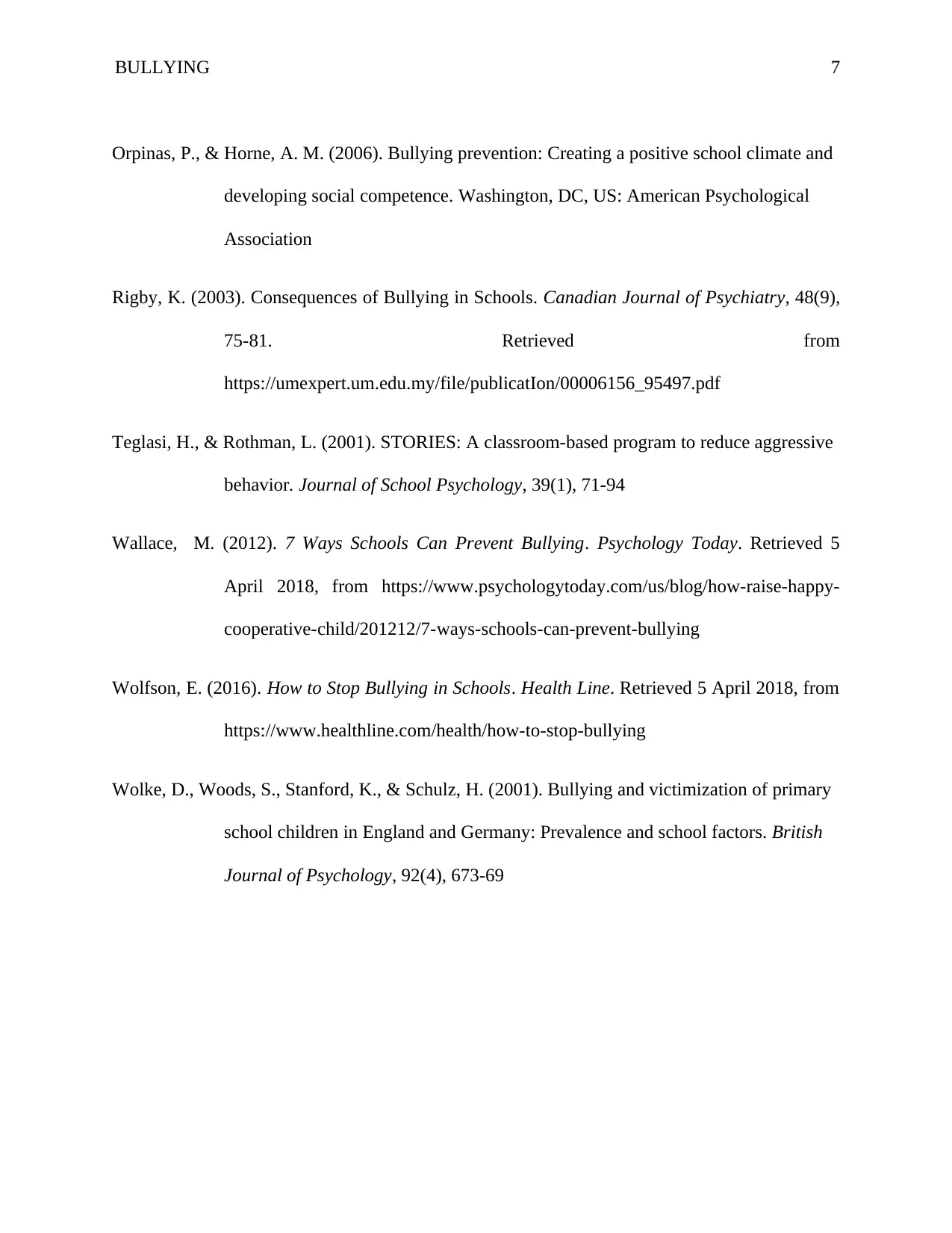Bullying Prevention Strategies in Canada: An ENGL 1100 Research Essay
VerifiedAdded on 2023/06/14
|7
|1606
|480
Essay
AI Summary
This essay examines the pervasive issue of bullying in Canada, highlighting its negative effects on victims and the importance of developing effective prevention strategies. It references various studies and articles that discuss the long-term consequences of bullying, including trauma, anxiety, and loss of self-esteem. The essay emphasizes the need for a collective effort involving parents, teachers, school administrators, and students to create a safe environment where children can thrive academically and socially without fear. Recommendations include establishing reporting systems in schools, incorporating bullying prevention lessons into the curriculum, implementing strict anti-bullying rules, and teaching children moral values that discourage violence and harassment. The study concludes that a collaborative approach is essential for eradicating bullying and ensuring a safe environment for all children in Canada and worldwide; Desklib provides access to similar essays and resources.

Running Head: BULLYING 1
Preventing Bullying in Canada
Name
Institution
Preventing Bullying in Canada
Name
Institution
Paraphrase This Document
Need a fresh take? Get an instant paraphrase of this document with our AI Paraphraser

BULLYING 2
Preventing Bullying in Canada
Over the past few years, bullying has become a significant concern in schools and the
societies throughout the world. Even in Canada, the vice has become so entrenched among
members of the society. In 2010, 49.5 percent of high school student in Canada reported to
victims or witnesses to acts of bullying. Today, 89 percent of Canadian teachers regard the vice
as a significant threat in public schools. It is noteworthy that both boys and girls alike are
affected by bullying, but in different ways. Whereas boys are most likely to be victims of
physical bullying, girls are victims to emotional aggression, sexual harassment, and cyber
bullying (Rigby, 2003). Additionally, statistics show that throughout the world, boys are more
likely to engage in physical bullying behavior. Bullying has significant negative effects to the
victim and society must develop a plan to reduce, prevent and eliminate its prevalence.
Various scholars, students and organizations have written about the issue of
bullying in schools and the society in general. The Canadian Department of Public Safety (n.d.)
wrote a paper on the prevention of bullying in schools. The article describes the methods that can
be adopted to prevent the vice from occurring in public schools within the country. It also
identifies the key long-term effects of bullying on the victim as trauma, anxiety, loss of self
esteem, and even the development of aggressive behavior. In addition, the paper highlights the
fact that bullying does not often begin and end at school. Instead, it continues even outside the
school environment and potentially throughout the individual’s life. As a result, it is important
for prevention measures to be instigated to cut the occurrence of the vice.
Additionally, Eriksen, Nielsen & Simonsen (2012) discuss on the issue of bullying and
its effects in elementary school. In their study, they describe bullying as a widespread social
Preventing Bullying in Canada
Over the past few years, bullying has become a significant concern in schools and the
societies throughout the world. Even in Canada, the vice has become so entrenched among
members of the society. In 2010, 49.5 percent of high school student in Canada reported to
victims or witnesses to acts of bullying. Today, 89 percent of Canadian teachers regard the vice
as a significant threat in public schools. It is noteworthy that both boys and girls alike are
affected by bullying, but in different ways. Whereas boys are most likely to be victims of
physical bullying, girls are victims to emotional aggression, sexual harassment, and cyber
bullying (Rigby, 2003). Additionally, statistics show that throughout the world, boys are more
likely to engage in physical bullying behavior. Bullying has significant negative effects to the
victim and society must develop a plan to reduce, prevent and eliminate its prevalence.
Various scholars, students and organizations have written about the issue of
bullying in schools and the society in general. The Canadian Department of Public Safety (n.d.)
wrote a paper on the prevention of bullying in schools. The article describes the methods that can
be adopted to prevent the vice from occurring in public schools within the country. It also
identifies the key long-term effects of bullying on the victim as trauma, anxiety, loss of self
esteem, and even the development of aggressive behavior. In addition, the paper highlights the
fact that bullying does not often begin and end at school. Instead, it continues even outside the
school environment and potentially throughout the individual’s life. As a result, it is important
for prevention measures to be instigated to cut the occurrence of the vice.
Additionally, Eriksen, Nielsen & Simonsen (2012) discuss on the issue of bullying and
its effects in elementary school. In their study, they describe bullying as a widespread social

BULLYING 3
phenomenon and show how children who are being bullied and those who bully others suffer
from long term consequences. Although the study was mainly based in Denmark, the study
shows that bullying may result in both direct and long term effects to the victims. As a result,
there study shows the importance of enacting anti-bullying mechanisms both in school and at
home to help provide a peaceful environment for children free from bullying.
Likewise, Limo (2015) wrote a paper on the issue of bullying among teenagers and its
effects on the victim. Similar to other papers, Limo acknowledges the fact that peer victimization
and harassment has become a serious concern among parents, students, teachers and society as a
whole. He describes bullying as a type of violence that threatens young people’s wellbeing,
especially those in school. In his study, Limo (2015) studies and explores the different kinds of
bullying, the most likely victims and perpetrators, their prevalence and the mental effects that
they have on the victims. The study concludes that bullying, whether in the form of cyber
bullying, physical or emotion harassment has a lasting effect on the development of the victim.
From the literature above, it is evident that bullying has tremendously negative effects
on victims. As a result, it is important for the society to develop a permanent solution to the
menace and offer children a safe environment both in school and at home that is free from
harassment and violence (“Bullying,” n.d.). Generally, preventing and eradicating bullying
involves a dedication to developing a safe environment where kids can blossom academically
and socially without fear (Wolke, Woods, Stanford, & Schulz, 2001). Noteworthy, this can be
achieved through a collective effort of parents, teachers and school administrators, as well as
students themselves.
phenomenon and show how children who are being bullied and those who bully others suffer
from long term consequences. Although the study was mainly based in Denmark, the study
shows that bullying may result in both direct and long term effects to the victims. As a result,
there study shows the importance of enacting anti-bullying mechanisms both in school and at
home to help provide a peaceful environment for children free from bullying.
Likewise, Limo (2015) wrote a paper on the issue of bullying among teenagers and its
effects on the victim. Similar to other papers, Limo acknowledges the fact that peer victimization
and harassment has become a serious concern among parents, students, teachers and society as a
whole. He describes bullying as a type of violence that threatens young people’s wellbeing,
especially those in school. In his study, Limo (2015) studies and explores the different kinds of
bullying, the most likely victims and perpetrators, their prevalence and the mental effects that
they have on the victims. The study concludes that bullying, whether in the form of cyber
bullying, physical or emotion harassment has a lasting effect on the development of the victim.
From the literature above, it is evident that bullying has tremendously negative effects
on victims. As a result, it is important for the society to develop a permanent solution to the
menace and offer children a safe environment both in school and at home that is free from
harassment and violence (“Bullying,” n.d.). Generally, preventing and eradicating bullying
involves a dedication to developing a safe environment where kids can blossom academically
and socially without fear (Wolke, Woods, Stanford, & Schulz, 2001). Noteworthy, this can be
achieved through a collective effort of parents, teachers and school administrators, as well as
students themselves.
⊘ This is a preview!⊘
Do you want full access?
Subscribe today to unlock all pages.

Trusted by 1+ million students worldwide

BULLYING 4
In order to prevent bullying in schools, school administrations should establish a
system for students to report any instances of bullying that the place within the institution and
help them get immediate help. In this case, the school should provide a counselor or other
professionals to help the victim overcome the incident (Olweus & Limber, 2010). In addition, the
school curriculum in Canada should include lessons that teach students on how to identify
bullying language and actions in themselves as well as their peers (Teglasi, & Rothman, 2001)
Moreover, they should be educated on positive communication skills to allow students to
communicate without engaging in violent acts that may harm their classmates (Wallace, 2012).
In addition, schools should develop a strict non-tolerance to violence and bullying
rules to help prevent and reduce the occurrence of bullying within the institution. This is to say
that, the school must develop song repercussions for bullying by marking it as an illegal offense
and anyone caught bullying another student is expelled (Wolfson, 2016). In turn, such zero
tolerance rules for the behavior will strongly discourage potential and existing bullies from
perpetrating their actions within the school environment (Olweus & Limber, 2010). In turn, the
strategy will help the school administration in making a step forward towards the prevention and
elimination of bullying among students and create a safe environment for all pupils.
Furthermore, parents and the society in general can take part in the fight against
bullying by teaching children moral values that discourage against acts of violence and
harassment such as bullying. Ordinarily, parents have a direct influence on their children’s social
behavior and character (Elvia, 2017). Many a times, bullies come from families characterized
with violence, lack of love and limited parental involvement (Hellwig, n.d.). Thus, parents are
charged with the responsibility of creating strict rules at home on how the child should behave
In order to prevent bullying in schools, school administrations should establish a
system for students to report any instances of bullying that the place within the institution and
help them get immediate help. In this case, the school should provide a counselor or other
professionals to help the victim overcome the incident (Olweus & Limber, 2010). In addition, the
school curriculum in Canada should include lessons that teach students on how to identify
bullying language and actions in themselves as well as their peers (Teglasi, & Rothman, 2001)
Moreover, they should be educated on positive communication skills to allow students to
communicate without engaging in violent acts that may harm their classmates (Wallace, 2012).
In addition, schools should develop a strict non-tolerance to violence and bullying
rules to help prevent and reduce the occurrence of bullying within the institution. This is to say
that, the school must develop song repercussions for bullying by marking it as an illegal offense
and anyone caught bullying another student is expelled (Wolfson, 2016). In turn, such zero
tolerance rules for the behavior will strongly discourage potential and existing bullies from
perpetrating their actions within the school environment (Olweus & Limber, 2010). In turn, the
strategy will help the school administration in making a step forward towards the prevention and
elimination of bullying among students and create a safe environment for all pupils.
Furthermore, parents and the society in general can take part in the fight against
bullying by teaching children moral values that discourage against acts of violence and
harassment such as bullying. Ordinarily, parents have a direct influence on their children’s social
behavior and character (Elvia, 2017). Many a times, bullies come from families characterized
with violence, lack of love and limited parental involvement (Hellwig, n.d.). Thus, parents are
charged with the responsibility of creating strict rules at home on how the child should behave
Paraphrase This Document
Need a fresh take? Get an instant paraphrase of this document with our AI Paraphraser

BULLYING 5
and treat his or her peers. By so doing, they would help nurture non-violent children and in turn
prevent bullying.
All factors taken into consideration, bullying is a significant issue that needs a
permanent solution. Overall, this study concludes that is important for society to provide a safe
environment for children to thrive without the fear of harassment. Mainly, this can be achieved
through the collaboration of parents, teachers, school administration, students and society as a
whole. This study is relevant in the present and future is that it will provide a basis for
developing structural systems that will help in eradicating the issue of bullying in Canada as well
as throughout the world.
and treat his or her peers. By so doing, they would help nurture non-violent children and in turn
prevent bullying.
All factors taken into consideration, bullying is a significant issue that needs a
permanent solution. Overall, this study concludes that is important for society to provide a safe
environment for children to thrive without the fear of harassment. Mainly, this can be achieved
through the collaboration of parents, teachers, school administration, students and society as a
whole. This study is relevant in the present and future is that it will provide a basis for
developing structural systems that will help in eradicating the issue of bullying in Canada as well
as throughout the world.

BULLYING 6
References
Bullying prevention in schools. (n.d.) Canadian Department of Public Safety. Retrieved 5 April
2018, from https://www.publicsafety.gc.ca/cnt/rsrcs/pblctns/bllng-prvntn-schls/
index-en.aspx
Bullying. (n.d.) American Psychological Association. Retrieved 5 April 2018, from
http://www.apa.org/helpcenter/bullying.aspx/How-parents-teachers-and-kids-can-
take-action-to-prevent-bullying
Elvia, E. (2017). How to Stop Bullying in Schools As Teachers, Parents & Bullying Victims —
Effective & Comprehensive Ways for You. Reolink. Retrieved 5 April 2018, from
https://reolink.com/how-to-stop-bullying-in-schools/
Eriksen, T., Nielsen, H., & Simonsen, M. (2012). The Effects of Bullying in Elementary School
(Phd.). Aarhus Univeristy.
Hellwig, E. (2012). 10 Ways to Help Reduce Bullying in Schools. CPI. Retrieved 5 April 2018,
from https://www.crisisprevention.com/Blog/November-2011/10-Ways-to-Help-
Reduce-Bullying-in-Schools
Limo, S. (2015). Bullying Among Teenagers and its Effects (Bachelor Thesis). Turku Univeristy
of Applied Sceince.
Olweus, D., & Limber, P. (2010). Bullying in School: Evaluation and Dissemination of the
Olweus Bullying Prevention Program. American Journal of Orthorpsychiatry,
9(1), 1-13
References
Bullying prevention in schools. (n.d.) Canadian Department of Public Safety. Retrieved 5 April
2018, from https://www.publicsafety.gc.ca/cnt/rsrcs/pblctns/bllng-prvntn-schls/
index-en.aspx
Bullying. (n.d.) American Psychological Association. Retrieved 5 April 2018, from
http://www.apa.org/helpcenter/bullying.aspx/How-parents-teachers-and-kids-can-
take-action-to-prevent-bullying
Elvia, E. (2017). How to Stop Bullying in Schools As Teachers, Parents & Bullying Victims —
Effective & Comprehensive Ways for You. Reolink. Retrieved 5 April 2018, from
https://reolink.com/how-to-stop-bullying-in-schools/
Eriksen, T., Nielsen, H., & Simonsen, M. (2012). The Effects of Bullying in Elementary School
(Phd.). Aarhus Univeristy.
Hellwig, E. (2012). 10 Ways to Help Reduce Bullying in Schools. CPI. Retrieved 5 April 2018,
from https://www.crisisprevention.com/Blog/November-2011/10-Ways-to-Help-
Reduce-Bullying-in-Schools
Limo, S. (2015). Bullying Among Teenagers and its Effects (Bachelor Thesis). Turku Univeristy
of Applied Sceince.
Olweus, D., & Limber, P. (2010). Bullying in School: Evaluation and Dissemination of the
Olweus Bullying Prevention Program. American Journal of Orthorpsychiatry,
9(1), 1-13
⊘ This is a preview!⊘
Do you want full access?
Subscribe today to unlock all pages.

Trusted by 1+ million students worldwide

BULLYING 7
Orpinas, P., & Horne, A. M. (2006). Bullying prevention: Creating a positive school climate and
developing social competence. Washington, DC, US: American Psychological
Association
Rigby, K. (2003). Consequences of Bullying in Schools. Canadian Journal of Psychiatry, 48(9),
75-81. Retrieved from
https://umexpert.um.edu.my/file/publicatIon/00006156_95497.pdf
Teglasi, H., & Rothman, L. (2001). STORIES: A classroom-based program to reduce aggressive
behavior. Journal of School Psychology, 39(1), 71-94
Wallace, M. (2012). 7 Ways Schools Can Prevent Bullying. Psychology Today. Retrieved 5
April 2018, from https://www.psychologytoday.com/us/blog/how-raise-happy-
cooperative-child/201212/7-ways-schools-can-prevent-bullying
Wolfson, E. (2016). How to Stop Bullying in Schools. Health Line. Retrieved 5 April 2018, from
https://www.healthline.com/health/how-to-stop-bullying
Wolke, D., Woods, S., Stanford, K., & Schulz, H. (2001). Bullying and victimization of primary
school children in England and Germany: Prevalence and school factors. British
Journal of Psychology, 92(4), 673-69
Orpinas, P., & Horne, A. M. (2006). Bullying prevention: Creating a positive school climate and
developing social competence. Washington, DC, US: American Psychological
Association
Rigby, K. (2003). Consequences of Bullying in Schools. Canadian Journal of Psychiatry, 48(9),
75-81. Retrieved from
https://umexpert.um.edu.my/file/publicatIon/00006156_95497.pdf
Teglasi, H., & Rothman, L. (2001). STORIES: A classroom-based program to reduce aggressive
behavior. Journal of School Psychology, 39(1), 71-94
Wallace, M. (2012). 7 Ways Schools Can Prevent Bullying. Psychology Today. Retrieved 5
April 2018, from https://www.psychologytoday.com/us/blog/how-raise-happy-
cooperative-child/201212/7-ways-schools-can-prevent-bullying
Wolfson, E. (2016). How to Stop Bullying in Schools. Health Line. Retrieved 5 April 2018, from
https://www.healthline.com/health/how-to-stop-bullying
Wolke, D., Woods, S., Stanford, K., & Schulz, H. (2001). Bullying and victimization of primary
school children in England and Germany: Prevalence and school factors. British
Journal of Psychology, 92(4), 673-69
1 out of 7
Your All-in-One AI-Powered Toolkit for Academic Success.
+13062052269
info@desklib.com
Available 24*7 on WhatsApp / Email
![[object Object]](/_next/static/media/star-bottom.7253800d.svg)
Unlock your academic potential
Copyright © 2020–2025 A2Z Services. All Rights Reserved. Developed and managed by ZUCOL.

